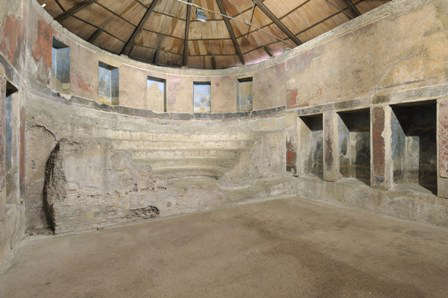
Walking along via Merulana, about halfway between the Basilica of Santa Maria Maggiore and via Labicana, there is an ancient monument, surrounded by grates and a pretty "little garden", known as the Auditorium of Mecenate.
The monument was brought to light in 1874 during the excavation works envisaged by the Regulatory Plan for the nascent Umbertino district on the Esquiline. It is an apsidal hall built at the end of the Republican age on a stretch of the Servian Walls and inserted into the embankment behind them. There are four parts: a vestibule to the southeast, consisting of a sort of rectangular hall, the hall itself and the stepped exedra, which has a radius of about 5 metres. The name of the building dates back to the moment of discovery. In fact, it was believed that it was an auditorium, an odeon (small covered theater) inside the Horti (gardens) of Mecenate. Instead, it is probable that it was a summer nymphaeum-triclinium, i.e. a partially underground room, therefore cooler, used for convivial meetings enlivened by water games. This had to flow on the steps of the apse and in a low central channel. This function also seems to be confirmed by the pictorial decoration of the room, dating back to the beginning of the 1st century AD. The walls have motifs of candelabra and peacocks on the sides, on a red background; the niches of the hall and apse are decorated with garden scenes with plants, flowers, birds, to give the illusion of windows opening onto green spaces. Today the Auditorium can only be visited with organized guided tours.
Information
Admission to the monument is allowed to groups and associations, with their own guide, who must make a reservation at 060608 (daily, 9.00 - 19.00).Maximum 30 people per visit.For individual visitors, who must also make a reservation at 060608, individual visits are also possible according to a schedule specified oMonumenti del territorioStarting from 01/08/2024 the site will be temporarily closed to the public for the start of the works envisaged by the PNRR
 Condividi
Condividi
Location
To find out about all accessibility services, visit the Rome accessible section.











































